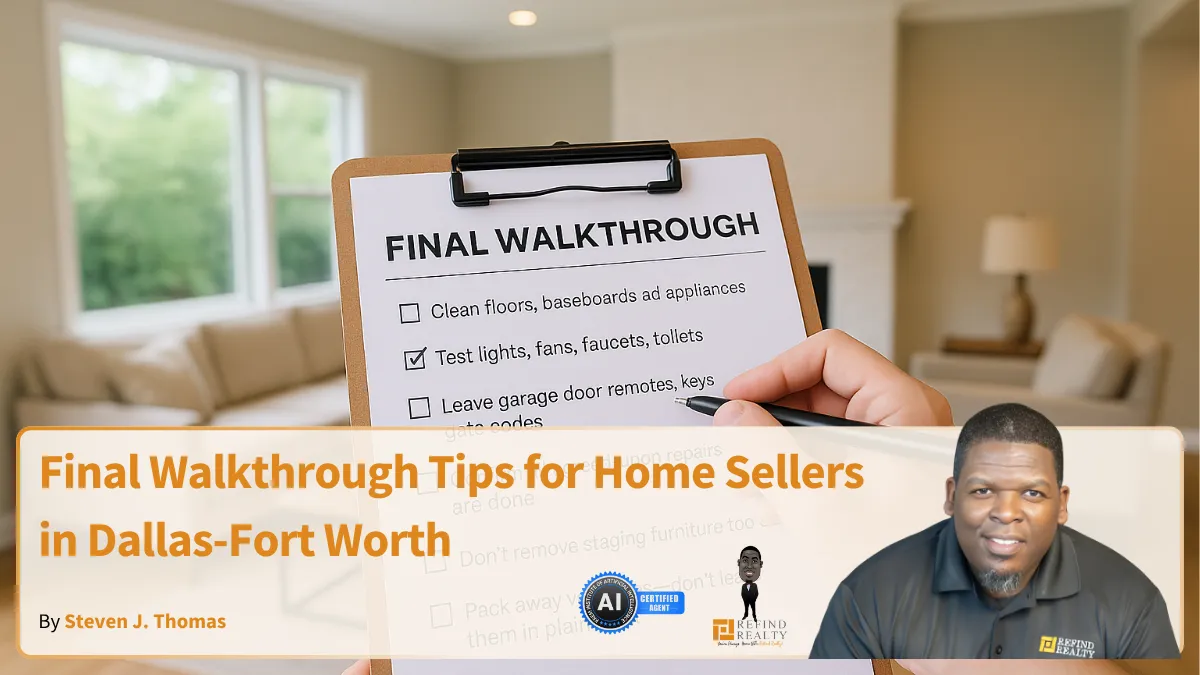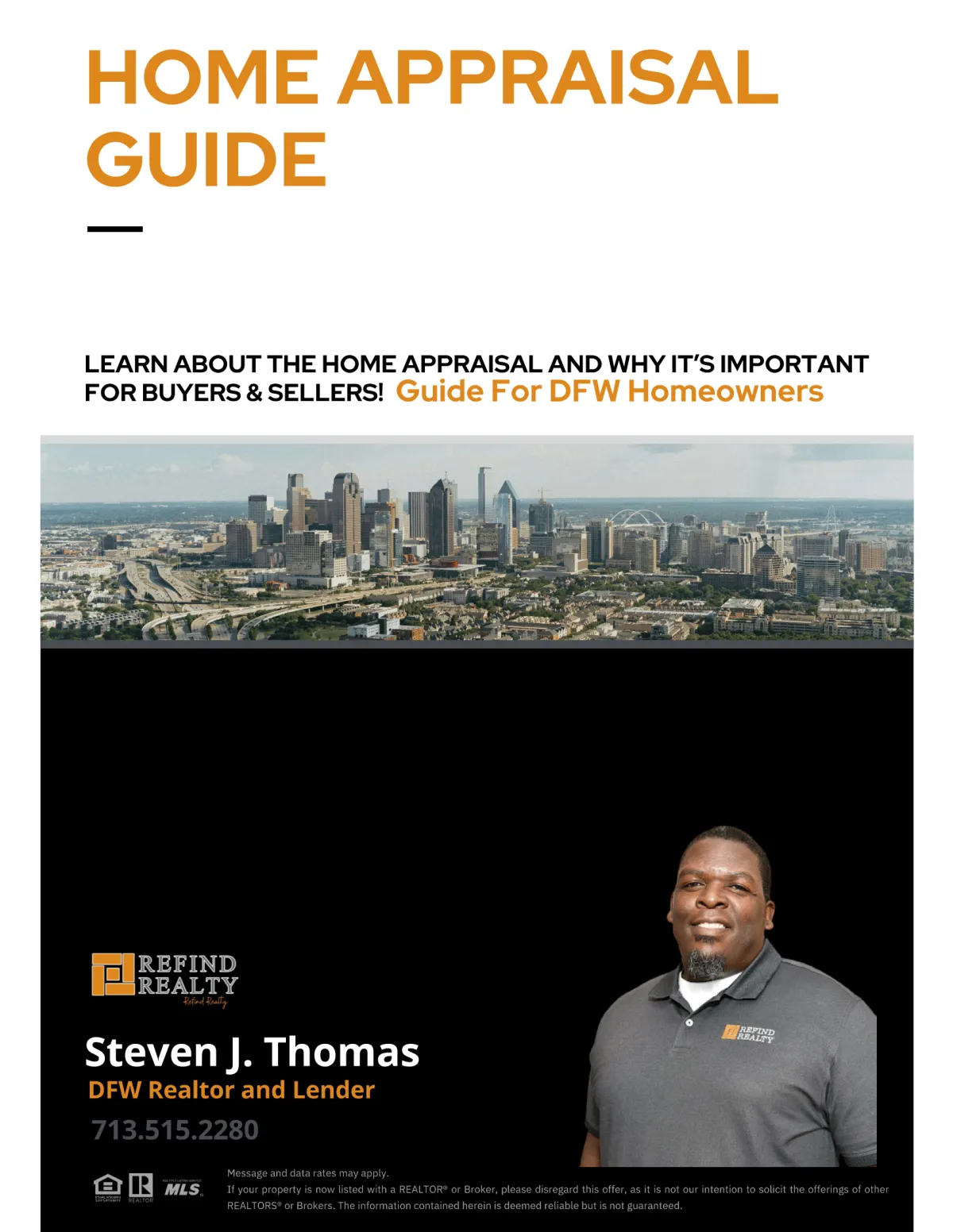You're Always At Home With Refind Realty.
Serving Your DFW Real Estate Needs Since 2005.
We Help You Buy and Sell in The Greater Dallas-Fort Worth Area.
Check Out Our Social Media Channels!
Buying in DFW
Buying your first or next home should be a rewarding and exciting time in your life, and one that you look back on with fond memories.
Thinking Of selling?
The market has changed a lot and I'd love to show you the exact strategy I use to get sellers in DFW top dollar for their property.
Get Pre-Approved
Let me walk you through the entire pre-approval process so you know exactly how much home you can afford.
Sign Up For my
Email List
My emails are a great way to stay up-to-date with local news and real estate market trends, even if you're not currently in the market. So, come on and join me to stay in the loop!
affordability Calculator
Get pre-approved to know exactly how much house you can afford. Use this calculator to get a quick estimate. Contact me for assistance!
DFW New Construction
Discover the latest new home constructions in DFW and take advantage of the builder incentives that are available now.


Owned and Operated by Thomas & Thomas Financial Group, LLC
Let's Make Your real estate Dreams Come True.
Newest Listings
Call Me Today At (713) 505-2280

Refind Realty Blog:


Final Walkthrough Tips for Home Sellers in Dallas-Fort Worth
Final Walkthrough Tips for Home Sellers in Dallas-Fort Worth
By Steven J. Thomas

Introduction
The finish line is in sight. Your home is under contract, closing is near, and now it’s time for the final walkthrough. This is your last shot to leave a lasting impression on your buyer. Missed details here can cost you—literally.
This guide gives you everything you need to make sure your final walkthrough goes smoothly, including expert insights, updated 2025 trends, and a checklist that ensures your home is ready.
And if you’re planning to sell or buy again soon, don’t forget to Download the Lone Star Living App now to explore your next move.
Neighborhood Spotlights: Why Walkthroughs Matter in DFW
Frisco & Prosper
These areas are booming with new construction and tech-driven transplants. Buyers expect modern finishes and spotless walkthroughs. It’s worth reviewing the New Construction Home Guide even for slightly older homes—they’ll compare yours to brand-new options nearby.
McKinney & Allen
Buyers here lean family-focused. Be sure to prep backyard play spaces, clean garage storage, and stage the kitchen to highlight everyday function.
Oak Cliff & Bishop Arts
Charming, artsy homes appeal to creative buyers. Showcase your home’s character but avoid clutter. Small flaws—like chipped paint or loose handles—can break the vibe. Use the Home Seller Checklist to catch the little stuff before buyers walk through.
2024–2025 Market Trends: Speed Matters
Homes in DFW sold 12% faster in Q2 2025 when walkthrough prep was prioritized.
Median time on market dropped to 28 days for homes that passed walkthroughs with zero issues.
In seller interviews, the top regret was not catching minor repairs sooner.
Tip: Track your prep using the Home Seller Score. It gives you a benchmark to see how close you are to being walkthrough-ready.
Expert quote:
“Buyers want to feel confident at the finish line. If something’s broken or dirty, they question everything—even if the rest of the sale went smooth.”
— James Lowry, DFW Listing Agent
Cost Breakdown: Common Fixes That Pay Off
Task Avg DFW Cost Why it Matters Patch holes in drywall $75–$150 Small flaws = big red flags Clean HVAC vents & filters $30–$100 Fresh air creates a ‘new home’ feel Replace burned out bulbs $10–$50 Bright rooms feel more spacious Clean appliances + fridge Free–$50 Buyers check everything Touch up paint + trim $100–$300 Looks updated without remodeling
Want to avoid unnecessary costs later? Explore your Home Selling Options to see what upgrades are really worth it.
Builder & Warranty Tips (If You’re Selling a Newer Home)
Selling a home built after 2020? You may still have active builder warranties. In your walkthrough prep:
Ensure punch-list items were completed.
Leave warranty paperwork visible on the counter.
List your builder in the listing notes. If they’re a name like Highland, Perry, or David Weekley, it builds trust.
Bonus: If you’re upgrading to a new build, check out our New Construction Homes Rebate Program and save thousands on your next purchase.
Financing & Incentives: Last-Minute Fixes
Final walkthroughs sometimes surface small issues. Instead of delaying the sale, you can:
Offer a small seller credit to cover it.
Show proof that the item is under warranty.
Provide receipts for recent repairs (HVAC, plumbing, electrical).
Buyers may also ask about pre-approval status or close-date flexibility. Forward them to our Pre-Approval Hub if needed—having this info available builds buyer confidence.
Final Walkthrough Checklist for Sellers
Before the walkthrough, review this final checklist:
Must-Do Items
Clean floors, baseboards, and appliances
Test lights, fans, faucets, toilets
Leave garage door remotes, keys, gate codes
Confirm all agreed-upon repairs are done
Don’t remove staging furniture too early
Pack away valuables—don’t leave them in plain sight
Bonus: Share your Home Seller Guide with buyers to smooth the transition. It builds goodwill and may help you avoid last-minute issues at closing.
Conclusion: Control What You Can
You can’t control the buyer’s mood or interest rates. But you can control the condition of your home. The final walkthrough is the moment buyers either feel reassured—or start second guessing.
A clean, functional, and well-prepared home sends one message: you took care of this place, and it’s ready for its next chapter.
Before you list your next property or search for new construction, Download the Lone Star Living App now to get hyper-local insights, property alerts, and builder rebate options.
You're Always Home With Refind Realty!
FAQs: Final Walkthroughs, Answered
When does the final walkthrough happen?
Usually 24–72 hours before closing, once the home is empty and cleaned.
Can the seller attend?
Yes—but it’s better to let your agent handle it unless there’s something specific to explain.
What if buyers find problems?
It depends. Minor issues may be ignored or credited. Major surprises can delay or cancel closing.
Do utilities need to stay on?
Yes. Everything must function properly during the walkthrough.
Is cleaning required after move-out?
Legally, no—but it’s expected. A clean home keeps your reputation intact.
What if you’re also buying?
Use the New Construction Webinar to explore options while prepping your current home for sale.
Stay Informed With My Downloadable
Buyer and Seller guides

6 Smart Ways to Build Home Equity

7 Insider Secrets To Selling Your Home w/o a Lot of Time or Money

DFW Home Seller Negotiation Secrets

Home Appraisals Guide

Avoiding Pitfalls That Can Derail Your Home's Sale

Ultimate Guide To Buying a Home

A First Time Homebuyers Guide In DFW

Are You Ready To Buy?

25 Insider Secrets To Buying A Home

How to Improve Your Credit
Download All My Guides For Free


Owned and Operated by Thomas & Thomas Financial Group, LLC
Steven J. Thomas
Steven J. Thomas has been in the financial services industry for the past 19 years and started my career as a Financial Planner for American Express Financial Advisors. I entered into banking with JP Morgan Chase as personal banker in 2003 and was promoted several times up to Small Business Specialist. I earned multiple Million Dollar Club awards and was ranked in the top 5 Small Business Specialist before I branched out in 2005 to start my own Financial Management Company. I ran a successful company before family circumstances lead me to Wachovia Bank in 2008 where I worked as a Senior Financial Specialist. As a Sr. Financial Specialist; I was responsible for the P & L and revenue growth of my banking center. The elimination of my role thru a bank merger lead me to BBVA Compass. I have held various leadership roles at BBVA Compass including Personal Relationship Manager, Branch Retail Executive, Workplace Solutions VP, and his current role as a Retail Manager. As the Regional Workplace Solutions VP, I was responsible for the strategic, tactical, and execution of Partnership Banking relationships, promotion and activity with corporate and non-profit companies in my footprint. I was responsible for the acquisition production for three districts, which includes 51 banking centers and over 300 employees. In May of 2014, I joined the team at Refind Realty and became one of the managing partners in mid-2015.
50+ 5 Star Reviews
Over $60,000,000 in Total Real Estate Sales
167 Properties Sold

Wondering What Your DFW Home Could Be Worth in 2025?
Get a Professional Home Valuation From A Local Market Expert
Unlock insights into potential selling prices.
Get a personalized analysis sent directly to your inbox.
Stay ahead with updates on property value fluctuations.
Benchmark your property against neighborhood listings.
Get a FREE Home Valuation And Potential Net Sheet:


I used this realtor and it was a great experience. He was patient and very helpful with our journey. He also helped us find a great lender with little hassle on the process, also got us approved for well above the market of our original home so we were able to get more house with a lower mortgage rate. So to anyone who is interested in buying a home take my advice give Steven a call. It’s worth it 😁
Bryant Loring


Steve was absolutely amazing! Everything was easy! Very professional in all aspects. Punctual, responsive, and diligent. He goes above and beyond to ensure you get to see as many homes as you’d like no matter the location. Not only was he knowledgeable about home buying, he also has a resourceful network for new home owner needs. I recommend Refind Realty to everyone!
Nicholas Bishop


I definitely recommend Steven to assist with your home buying needs. As a first time home buyer the process can be overwhelming, but as my realtor he was knowledgeable & patient while addressing my concerns and assisting me with my new home purchase. Thanks again Steven!! :-)
Gayle Mason

Ask Us Anything
Frequently Asked Questions
Why do you need a Realtor?
When buying or selling a home, there are so many options…which can also present a lot of obstacles. Laws change, forms change, and practices change all the time in the real estate industry. Because it’s our job to stay on top of those things, hiring a realtor reduces risk, and can also save you a lot of money in the long run.
When you work with me as your Realtor, you’re getting an expert who knows the area; knows how to skillfully guide your experience as a seller or buyer; can easily spot the difference between a good deal and a great deal. My job is to translate your dream into a real estate reality, and I work hard to earn and keep my business. This also means earning your trust: When you work with me, you’ll be working with a realtor who looks out for your best interests and is invested in your goals.
Which loan should you choose?
There are two different types of loans conventional loans and government-backed loans. The main difference is who insures these loans:
1 - Government-backed loans (FHA, VA and USDA):
(a) - Are, unsurprisingly, backed by the government.
(b) - Include FHA loans, VA loans, and USDA loans.
(c) - Make up less than 40 percent of the home loans generated in the U.S. each year.
2 - Conventional loans
(a) - Are not backed by the government.
(b) - Include conforming and non-conforming loans (such as jumbo loans).
(c) - Make up more than 60 percent of the loans generated in the U.S. each year.
What is the difference between FHA, VA and USDA loans?
1 - FHA LOANS:
FHA loans, which are insured by the Federal Housing Administration, are typically designed to meet the needs of first-time homebuyers with low or moderate incomes. FHA loans can be approved with a down payment of as little as 3.5 percent and a credit score as low as 580.
FHA loans are often called “helper loans,” because they give a leg up to potential borrowers who may not be able to secure one otherwise. For this reason, FHA loans have maximum lending limits, which are determined based on housing values for the county where the for-sale home is located.
Because the agency is taking on more risk by insuring FHA loans, the borrower is expected to pay mortgage insurance both at the time of closing and on a monthly basis, and the property must be owner-occupied.
2 - VA LOANS:
VA loans are backed by the Department of Veterans Affairs and they are guaranteed to qualified veterans and active-duty personnel and their spouses. VA loans can be approved with 100 percent financing, meaning VA borrowers are not required to make a down payment.
Unlike FHA loans, borrowers do not have to pay mortgage insurance on VA loans.
3 - USDA LOANS:
You may also hear about USDA loans, which are backed by the United States Department of Agriculture mortgage program. USDA loans are intended to support homeowners who purchase homes in rural and some suburban areas. USDA loans do not require a down payment and may offer lower interest rates; borrowers may have to pay a small mortgage insurance premium in order to offset the lender’s risk.
What’s a conventional loan? Understanding what it means to be conforming and non-conforming
Buyers who have a more established credit history and a larger down payment may prefer to apply for a conventional loan. These loans may offer a lower interest rate and only require the home buyer to purchase monthly mortgage insurance while the loan-to-value ratio is above a certain percentage, so a conventional loan borrower can typically save money in the long run.
Conventional loans are divided into two types: Conforming loans and non-conforming loans.
1 - CONFORMING LOANS:
Conforming loans are those that meet (or conform to) predetermined standards set by Fannie Mae and Freddie Mac — two government-sponsored institutions that buy and sell mortgages on the secondary market. By selling the loans to "Fannie and Freddie," lenders can free up their capital and return to issue more mortgages than if they had to personally back every loan that they approve.
The main standard for conforming loans is that the amount borrowed must be under a certain amount; in Alaska, a single-family home loan must be under $647,200 in order to be considered conforming.
Properties with more than one unit have higher limits.
2 - NON-CONFORMING (JUMBO) LOANS:
But what happens if a borrower wants to borrow more than the Freddie- and Fannie-approved loan amount? In this case, they would have to apply for a “jumbo loan,” which is the most common type of non-conforming loan.
Because the lender cannot resell the jumbo loan (or any non-conforming loan) to Freddie Mac or Fannie Mae, jumbo loans are considered to be riskier than a conforming loan. To protect against this risk, the bank will typically require a higher down payment; the interest rate on a jumbo loan may also be higher than if the same borrower applied for a conforming loan.
What kind of rate should you choose?
Rate types: Fixed-rate vs. adjustable-rate mortgages.
In addition to the loan type you choose, you’ll also have to determine if you want a fixed-rate mortgage or an adjustable-rate mortgage (ARM). A fixed-rate mortgage has an interest rate that does not change for the life of the loan, so it provides predictable monthly payments of principal and interest.
An adjustable-rate mortgage typically offers an initial introductory period with a low-interest rate. Once this period is over, the interest rate adjusts periodically, based on the market index. The initial interest rate on an ARM can sometimes be locked in for different periods, such as one, three, five, seven, or 10 years. Once the introductory period is over, the interest rate typically readjusts annually.
Office 1229 E. Pleasant Run Ste 224, DeSoto TX 75115
Call :(713) 505-2280
Email: [email protected]
Site: www.stevenjthomas.com

Facebook
Instagram
X
LinkedIn
Youtube
TikTok